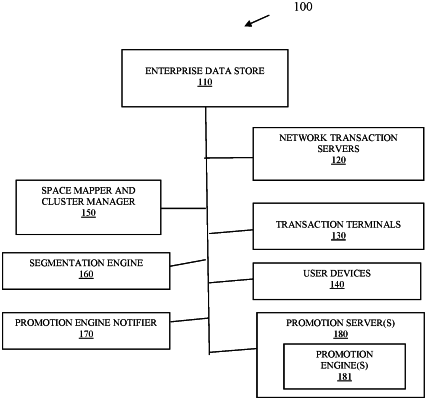| CPC G06Q 30/0201 (2013.01) [G06F 18/23213 (2023.01); G06N 20/00 (2019.01); G06Q 30/0224 (2013.01)] | 18 Claims |

|
1. A method, comprising:
providing executable instructions to a processor causing the processor to perform operations comprising:
transforming item codes for items of a product catalogue into item vectors plotted into a multidimensional space and determining dimensions of the multidimensional space based on a total number of unique item codes detected in the product catalogue, and expressing each item vector as a collection of coordinates plotted within the dimensions of the multidimensional space, wherein each item vector plotted within the multidimensional space represents affinities between the corresponding item vector to remaining ones of the item vectors plotted within the multidimensional space;
obtaining transaction histories for customers;
identifying transaction item vectors for transaction items of the transaction histories on a per customer basis based on the item codes and the item vectors present in each transaction for the corresponding customer, and summing each corresponding item vectors present within a corresponding transaction to obtain each transaction item vector, wherein each customer associated with a plurality of transaction vectors, each transaction vector for the corresponding customer representing a specific transaction of the corresponding customer;
summing transaction item vectors per customer and producing an aggregate consumer-item vector that is plotted within the multidimensional space per customer, wherein each aggregate consumer-item vector represents the corresponding customer's transaction vectors, each transaction vector for the corresponding customer represents given items purchased by the corresponding customer in a given transaction;
clustering the aggregate consumer-item vectors for the customers from the multidimensional space and producing customer groupings as segments based on calculated distances within the multidimensional space between each aggregate consumer-item vector;
providing the segments through an Application Programming Interface (API) to a promotion engine or a loyalty system causing delivery of the customer promotions by the promotion engine or the loyalty system to select customers of select segments, providing further includes providing each customer's corresponding aggregate consumer-item vector as a numerical and mathematical context for evaluating the corresponding customer's transaction history; and
processing the method as a Software as a Service from a cloud and providing the segments based on dynamic data-driven analysis to the promotion engine or the loyalty system through the API as data-driven segmentation for the customers defined in the segments and not in predefined rules managed by the promotion engine or the loyalty system, wherein no particular segment is predefined and wherein no rules are processed to assign a particular customer to a particular segment through the API, and wherein the segments change dynamically as changes are updated to the transaction histories for each customer.
|